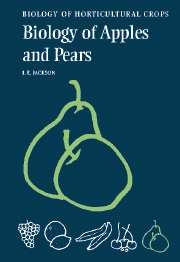Book contents
- Frontmatter
- Contents
- Preface
- Acknowledgements
- Introduction
- 1 The growing of apples and pears
- 2 Apples and pears and their relatives
- 3 Apple and pear root systems: induction, development, structure and function
- 4 The graft union, grafting and budding
- 5 Mechanisms of rootstock and interstock effects on scion vigour
- 6 The shoot system
- 7 Leaves, canopies and light interception
- 8 Photosynthesis, respiration, and carbohydrate transport, partitioning and storage
- 9 Flowers and fruits
- 10 Eating quality and its retention
- 11 Mineral nutrition
- 12 Water relations
- 13 Diseases, pests, and resistance to these
- 14 Biotechnology of apples and pears
- Cultivar Index
- General Index
- References
9 - Flowers and fruits
Published online by Cambridge University Press: 13 August 2009
- Frontmatter
- Contents
- Preface
- Acknowledgements
- Introduction
- 1 The growing of apples and pears
- 2 Apples and pears and their relatives
- 3 Apple and pear root systems: induction, development, structure and function
- 4 The graft union, grafting and budding
- 5 Mechanisms of rootstock and interstock effects on scion vigour
- 6 The shoot system
- 7 Leaves, canopies and light interception
- 8 Photosynthesis, respiration, and carbohydrate transport, partitioning and storage
- 9 Flowers and fruits
- 10 Eating quality and its retention
- 11 Mineral nutrition
- 12 Water relations
- 13 Diseases, pests, and resistance to these
- 14 Biotechnology of apples and pears
- Cultivar Index
- General Index
- References
Summary
The defining characteristics of apple and pear flowers and fruits were summarized in Chapter 2 and the morphology and anatomy of apple flowers and fruits comprehensively reviewed by Pratt (1988). Flowers are initiated and develop within the buds borne terminally on fruiting spurs (short shoots) and terminally or laterally on long shoots. These buds, as discussed in Chapter 6, consist essentially of a shortened shoot axis with a ‘leaf formation’ inserted at each node. These ‘leaf formations’ in apple commonly consist of about nine bud scales, three transition leaves, six true leaves and three bracts (cf. Figure 6.2, p. 159). Flower primordia may form at the apex and in the axils of the bracts and the three uppermost leaves (Abbott, 1970). Alternatively, the buds may fail to develop far enough to produce flowers and remain vegetative.
Juvenility
Seedling apple and pear trees usually remain vegetative for several years after seed germination. During this ‘juvenile’ phase they readily form adventitious roots, as discussed in Chapter 3, are often thorny and have a distinctive leaf shape and, especially, cannot be induced to flower (Zimmerman, 1972). They emerge from this juvenile state after reaching a minimum size, characteristic of the cultivar, measured as height or number of main stem nodes. The duration of the juvenile phase can be shortened by growing the seedling tree under conditions which speed up its growth or by specific horticultural practices such as grafting the seedling on to a dwarfing rootstock.
- Type
- Chapter
- Information
- The Biology of Apples and Pears , pp. 268 - 340Publisher: Cambridge University PressPrint publication year: 2003
References
- 1
- Cited by



